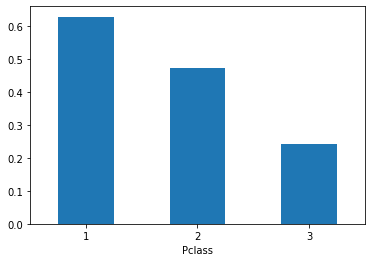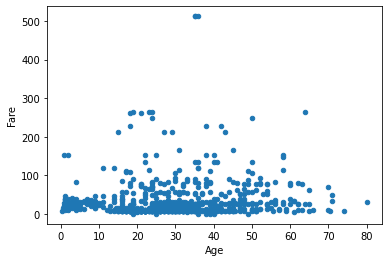import pandas as pd #판다스
from sklearn.linear_model import LogisticRegression #로지스틱 회귀 모델
from sklearn.tree import DecisionTreeClassifier #의사결정 나무 모델
#데이터 불러오기
train=pd.read_csv('../input/titanic/train.csv') #모델 학습
test=pd.read_csv('../input/titanic/test.csv') #모델 시험지
submission=pd.read_csv('../input/titanic/gender_submission.csv') #답안지
EDA
train.head()
| PassengerId | Survived | Pclass | Name | Sex | Age | SibSp | Parch | Ticket | Fare | Cabin | Embarked | |
|---|---|---|---|---|---|---|---|---|---|---|---|---|
| 0 | 1 | 0 | 3 | Braund, Mr. Owen Harris | male | 22.0 | 1 | 0 | A/5 21171 | 7.2500 | NaN | S |
| 1 | 2 | 1 | 1 | Cumings, Mrs. John Bradley (Florence Briggs Th... | female | 38.0 | 1 | 0 | PC 17599 | 71.2833 | C85 | C |
| 2 | 3 | 1 | 3 | Heikkinen, Miss. Laina | female | 26.0 | 0 | 0 | STON/O2. 3101282 | 7.9250 | NaN | S |
| 3 | 4 | 1 | 1 | Futrelle, Mrs. Jacques Heath (Lily May Peel) | female | 35.0 | 1 | 0 | 113803 | 53.1000 | C123 | S |
| 4 | 5 | 0 | 3 | Allen, Mr. William Henry | male | 35.0 | 0 | 0 | 373450 | 8.0500 | NaN | S |
PassengerId: 탑승객의 고유 아이디/ Survival: 생존유무(0: 사망, 1: 생존)/ Pclass: 등실의 등급/
Name:이름/ Sex: 성별/ Age: 나이/ Sibsp: 함께 탑승한 형제자매, 아내, 남편의 수/
Parch: 함께 탑승한 부모, 자식의 수/ Ticket: 티켓번호/ Fare: 티켓의 요금/
Cabin: 객실번호/ Embarked: 배에 탑승한 위치(C = Cherbourg, Q = Queenstown, S = Southampton)
test.head()
| PassengerId | Pclass | Name | Sex | Age | SibSp | Parch | Ticket | Fare | Cabin | Embarked | |
|---|---|---|---|---|---|---|---|---|---|---|---|
| 0 | 892 | 3 | Kelly, Mr. James | male | 34.5 | 0 | 0 | 330911 | 7.8292 | NaN | Q |
| 1 | 893 | 3 | Wilkes, Mrs. James (Ellen Needs) | female | 47.0 | 1 | 0 | 363272 | 7.0000 | NaN | S |
| 2 | 894 | 2 | Myles, Mr. Thomas Francis | male | 62.0 | 0 | 0 | 240276 | 9.6875 | NaN | Q |
| 3 | 895 | 3 | Wirz, Mr. Albert | male | 27.0 | 0 | 0 | 315154 | 8.6625 | NaN | S |
| 4 | 896 | 3 | Hirvonen, Mrs. Alexander (Helga E Lindqvist) | female | 22.0 | 1 | 1 | 3101298 | 12.2875 | NaN | S |
submission.head() #여성 1 남성 0
| PassengerId | Survived | |
|---|---|---|
| 0 | 892 | 0 |
| 1 | 893 | 1 |
| 2 | 894 | 0 |
| 3 | 895 | 0 |
| 4 | 896 | 1 |
- 훈련 데이터, 테스트 데이터 파악
print(train.shape) #속성을 나타내는 shape 메소드는 ()쓰지 않는다.
print(test.shape) #각 파일의 데이터 크기 파악
print(submission.shape)
(891, 12)
(418, 11)
(418, 2)
train.info() #기본적이고 전체적인 데이터 파악
<class 'pandas.core.frame.DataFrame'>
RangeIndex: 891 entries, 0 to 890
Data columns (total 12 columns):
# Column Non-Null Count Dtype
--- ------ -------------- -----
0 PassengerId 891 non-null int64
1 Survived 891 non-null int64
2 Pclass 891 non-null int64
3 Name 891 non-null object
4 Sex 891 non-null object
5 Age 714 non-null float64
6 SibSp 891 non-null int64
7 Parch 891 non-null int64
8 Ticket 891 non-null object
9 Fare 891 non-null float64
10 Cabin 204 non-null object
11 Embarked 889 non-null object
dtypes: float64(2), int64(5), object(5)
memory usage: 83.7+ KB
test.info()
<class 'pandas.core.frame.DataFrame'>
RangeIndex: 418 entries, 0 to 417
Data columns (total 11 columns):
# Column Non-Null Count Dtype
--- ------ -------------- -----
0 PassengerId 418 non-null int64
1 Pclass 418 non-null int64
2 Name 418 non-null object
3 Sex 418 non-null object
4 Age 332 non-null float64
5 SibSp 418 non-null int64
6 Parch 418 non-null int64
7 Ticket 418 non-null object
8 Fare 417 non-null float64
9 Cabin 91 non-null object
10 Embarked 418 non-null object
dtypes: float64(2), int64(4), object(5)
memory usage: 36.0+ KB
print(train.describe()) #각 데이터의 기술 통계량 확인
print(test.describe())
PassengerId Survived Pclass Age SibSp \
count 891.000000 891.000000 891.000000 714.000000 891.000000
mean 446.000000 0.383838 2.308642 29.699118 0.523008
std 257.353842 0.486592 0.836071 14.526497 1.102743
min 1.000000 0.000000 1.000000 0.420000 0.000000
25% 223.500000 0.000000 2.000000 20.125000 0.000000
50% 446.000000 0.000000 3.000000 28.000000 0.000000
75% 668.500000 1.000000 3.000000 38.000000 1.000000
max 891.000000 1.000000 3.000000 80.000000 8.000000
Parch Fare
count 891.000000 891.000000
mean 0.381594 32.204208
std 0.806057 49.693429
min 0.000000 0.000000
25% 0.000000 7.910400
50% 0.000000 14.454200
75% 0.000000 31.000000
max 6.000000 512.329200
PassengerId Pclass Age SibSp Parch Fare
count 418.000000 418.000000 332.000000 418.000000 418.000000 417.000000
mean 1100.500000 2.265550 30.272590 0.447368 0.392344 35.627188
std 120.810458 0.841838 14.181209 0.896760 0.981429 55.907576
min 892.000000 1.000000 0.170000 0.000000 0.000000 0.000000
25% 996.250000 1.000000 21.000000 0.000000 0.000000 7.895800
50% 1100.500000 3.000000 27.000000 0.000000 0.000000 14.454200
75% 1204.750000 3.000000 39.000000 1.000000 0.000000 31.500000
max 1309.000000 3.000000 76.000000 8.000000 9.000000 512.329200
train['Embarked'].value_counts() #배에 탑승한 위치
S 644
C 168
Q 77
Name: Embarked, dtype: int64
train['Embarked'].unique() #unique 메소드는 시리즈로 접근
array(['S', 'C', 'Q', nan], dtype=object) #나오는 순서대로 나옴
train.groupby('Sex').mean()
| PassengerId | Survived | Pclass | Age | SibSp | Parch | Fare | |
|---|---|---|---|---|---|---|---|
| Sex | |||||||
| female | 431.028662 | 0.742038 | 2.159236 | 27.915709 | 0.694268 | 0.649682 | 44.479818 |
| male | 454.147314 | 0.188908 | 2.389948 | 30.726645 | 0.429809 | 0.235702 | 25.523893 |
train.groupby('Pclass').mean()
| PassengerId | Survived | Age | SibSp | Parch | Fare | |
|---|---|---|---|---|---|---|
| Pclass | ||||||
| 1 | 461.597222 | 0.629630 | 38.233441 | 0.416667 | 0.356481 | 84.154687 |
| 2 | 445.956522 | 0.472826 | 29.877630 | 0.402174 | 0.380435 | 20.662183 |
| 3 | 439.154786 | 0.242363 | 25.140620 | 0.615071 | 0.393075 | 13.675550 |
#시각화
#pd.Series.plot(kind='bar')
train.groupby('Pclass').mean()['Survived'].plot(kind='bar', rot=0) #rot=0 x축 명칭 회전 수정/ rot=45는 비스듬히(각도)
<AxesSubplot:xlabel='Pclass'>

train['Age'].plot(kind='hist',bins=50,grid=True) #bins 도수를 더 잘게 나눔 grid로 보조선까지 추가
<AxesSubplot:ylabel='Frequency'>

train.plot(x='Age',y='Fare',kind='scatter')
<AxesSubplot:xlabel='Age', ylabel='Fare'>

데이터 전처리
#결측값 파악
train.isna().sum()
PassengerId 0
Survived 0
Pclass 0
Name 0
Sex 0
Age 177
SibSp 0
Parch 0
Ticket 0
Fare 0
Cabin 687
Embarked 2
dtype: int64
- 나이 결측값 해결
train['Age'].median() #중앙값으로 대체
28.0
train['Age'].fillna(28)#이것만 쓰면 저장이 안됨! 일시적으로 나타내주기만 한다.
train['Age']=train['Age'].fillna(28) #train['Age'] 에 다시 저장
train.isna().sum() #Age 확인
PassengerId 0
Survived 0
Pclass 0
Name 0
Sex 0
Age 0
SibSp 0
Parch 0
Ticket 0
Fare 0
Cabin 687
Embarked 2
dtype: int64
- 좌석 등급 결측값
train['Embarked'].value_counts()
S 644
C 168
Q 77
Name: Embarked, dtype: int64
train['Embarked']=train['Embarked'].fillna('S') #제일 많은 값인 S로 채워주겠다.
train.isna().sum() #Embarked 확인
PassengerId 0
Survived 0
Pclass 0
Name 0
Sex 0
Age 0
SibSp 0
Parch 0
Ticket 0
Fare 0
Cabin 687
Embarked 0
dtype: int64
- 객실번호는 유의미한 변수가 아니라 판단, 전처리 과정에서 제외하겠다.
#pd.Series.map() #시리즈 내 값을 변환할 때 사용하는 함수
#남자는 0, 여자는 1로 값 변경
train['Sex']=train['Sex'].map({'male':0,'female':1})
train['Sex']
0 0
1 1
2 1
3 1
4 0
..
886 0
887 1
888 1
889 0
890 0
Name: Sex, Length: 891, dtype: int64
모델링
#X -> MODEL -> y
#변수는 성별과 좌석 등급으로 정했다.
X_train=train[['Sex','Pclass']]
y_train=train['Survived']
test['Sex']=test['Sex'].map({'male':0,'female':1})
X_test=test[['Sex','Pclass']]
X_test
| Sex | Pclass | |
|---|---|---|
| 0 | 0 | 3 |
| 1 | 1 | 3 |
| 2 | 0 | 2 |
| 3 | 0 | 3 |
| 4 | 1 | 3 |
| ... | ... | ... |
| 413 | 0 | 3 |
| 414 | 1 | 1 |
| 415 | 0 | 3 |
| 416 | 0 | 3 |
| 417 | 0 | 3 |
418 rows × 2 columns
lr=LogisticRegression()
dt=DecisionTreeClassifier()
lr.fit(X_train,y_train)
LogisticRegression()
dt.fit(X_train,y_train)
DecisionTreeClassifier()
lr_pred=lr.predict_proba(X_test)[:,1]
dt_pred=dt.predict_proba(X_test)[:,1]
submission['Survived']=lr_pred
submission
| PassengerId | Survived | |
|---|---|---|
| 0 | 892 | 0.102021 |
| 1 | 893 | 0.593544 |
| 2 | 894 | 0.224759 |
| 3 | 895 | 0.102021 |
| 4 | 896 | 0.593544 |
| ... | ... | ... |
| 413 | 1305 | 0.102021 |
| 414 | 1306 | 0.904848 |
| 415 | 1307 | 0.102021 |
| 416 | 1308 | 0.102021 |
| 417 | 1309 | 0.102021 |
418 rows × 2 columns
submission.to_csv('logistic_regression_pred.csv',index=False) #False 안하면 행을 나타내는 인덱스가 같이 저장됨
submission['Survived']=dt_pred
submission
| PassengerId | Survived | |
|---|---|---|
| 0 | 892 | 0.135447 |
| 1 | 893 | 0.500000 |
| 2 | 894 | 0.157407 |
| 3 | 895 | 0.135447 |
| 4 | 896 | 0.500000 |
| ... | ... | ... |
| 413 | 1305 | 0.135447 |
| 414 | 1306 | 0.968085 |
| 415 | 1307 | 0.135447 |
| 416 | 1308 | 0.135447 |
| 417 | 1309 | 0.135447 |
418 rows × 2 columns
submission.to_csv('decision_tree_pred.csv',index=False) #정답지 제출
-
로지스틱, 결정트리모형을 이용해 제출해봤으나 비슷한 점수가 나왔고 추후 로지스틱 회귀 모형에 변수를 추가하는 방식으로 접근했다.
-
올바른 변수를 선택하는 법을 조금 더 고려해보아야 할 것 같다.
Reference:
-
데이콘의 타이타닉 생존자 예측하기 실습
-
Kaggle의 타이타닉 생존자 예측 데이터 자료